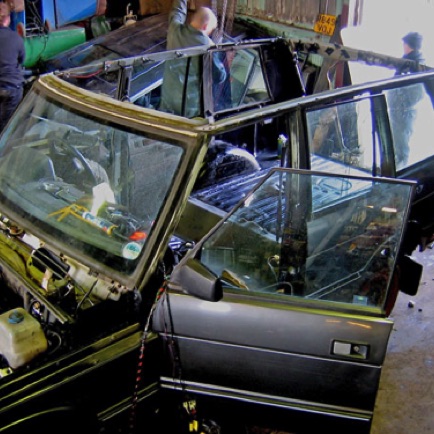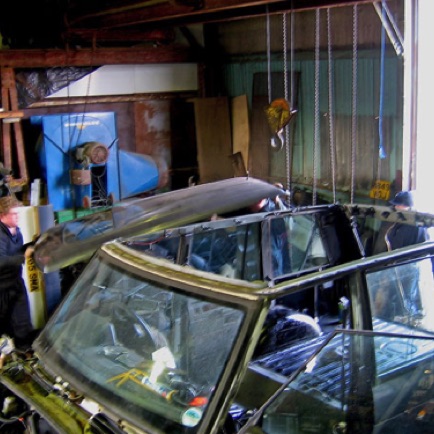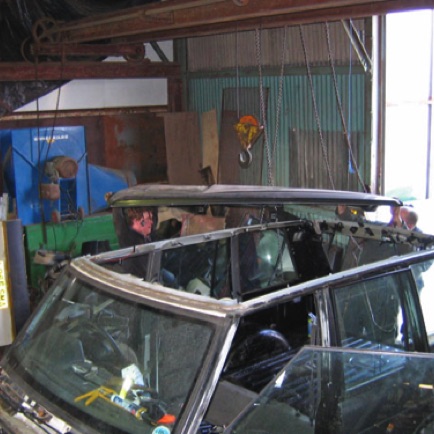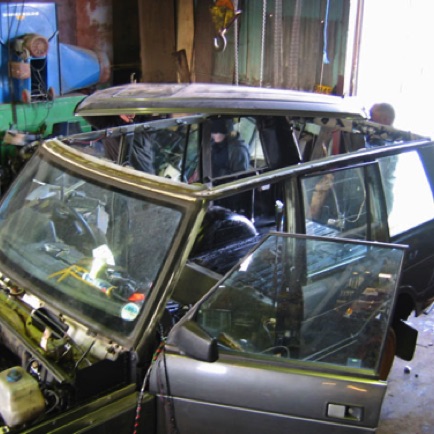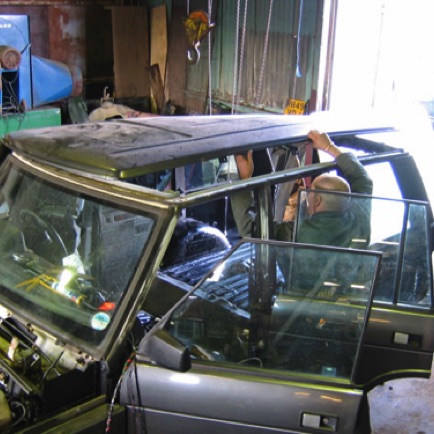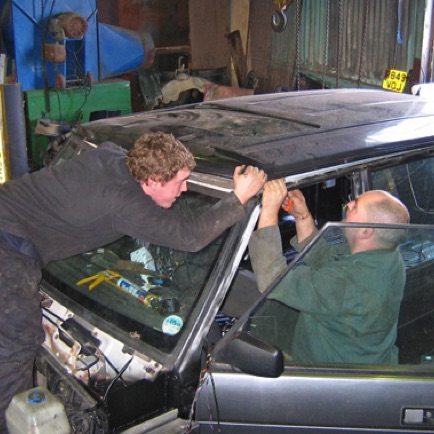Time to play hunt the front seats, and to swap panels over from a donor Vogue SE, in this episode
PANELS AND TRIM FOR THE REBORN RANGE ROVER
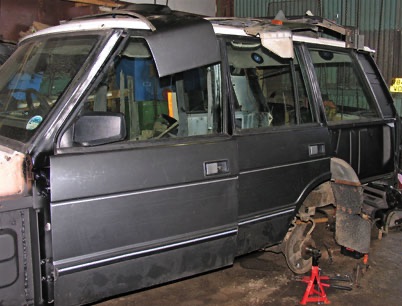
CLASSIC RANGE ROVER RECYCLED – Part 3
Following our first two episodes covering the acquisition, strip-down and much of the motor work on its 300 TDi 4-cylinders, this month the emphasis is on the now corrosion-treated body and its interior and exterior fittings.
The most obvious progress once the engine and 4x4 transmission components had been removed, came in the repair and renovation of rustier sections — detailed in our last episode — and the February 2007 onward installation of exterior panelling. These metallic dark grey panels appear to be in the original factory Pembroke Grey. They came from a K-plate Vogue SE of the early 1990s whose V8 motor (aftermarket turbocharged, and apparently belonging to an intrepid Nurburgring tripper) had expired.
What mattered to us was a remarkably clean set of panels that could serve the project car. There were a few ‘tinks’, dents and scratches, but not nearly so many as when our machine was finished. Lesson of experience: do not pile redundant trim and items awaiting transplant on the roof, and don’t let the bonnet sniff anything other than clean and flat storage. Otherwise you will end up with our problems: a slightly twisted bonnet and a lot more superficial paint damage than was evident in the first place.
It would also have helped if we had stuck to the original plan and had the vehicle sprayed literally next door, so there was no possibility of dirty travel between panel fitting and painting. In the event time and money ran out, so the used panels were deployed in original condition. It is also worth noting that the undersealing was applied much later than planned: we used Waxoyl after anticipated Dinitrol supplies did not materialise.
Incidentally one of the Range Rovers to pass onto the FBB lot was a spooky coincidence. The next registration number in the L---SMA series to ours. Also ex-police, but it was no material aid to this project as one of our workers bought it. Unfortunately it was not mechanically reliable — head gaskets and clutch failure were almost immediate — but it is still around, now in sturdier health on a second 200 TDi motor.
Back outside, the project Range, both tailgates (upper and lower), plus the front and rear bumpers were strangers to this vehicle, but not strangers to rust. Worst offenders were the bumpers and upper tailgate. The lower tailgate was perfectly acceptable with a little TLC, the upper needed more work but was better than most we had seen on our earlier Range Rover or loan vehicles. The rear bumper rubbed down and shone for the camera, but the front was as bad underneath as the original project Range had been. Depressing.
So what did we cannibalise from that 1992-3 Vogue? Basically our recycled exterior of front wings, plus four side doors for front and rear. All but one interior mechanism and wood trim was transferred over as well. We also took both rear side panels aft of the back doors, plus bonnet and roof.
That meant the rear side and front windscreen remained as the only original glass, for we tried several upper tailgates before we got one that was a little less rusty than the rest. It also meant we had those unusual heater elements embedded in one rear three-quarter rear glass panel, a feature this writer had not seen previously
Back at panel swapping time, all but the roof and the three-quarter rear ‘wings’ were in place by mid-February. At the end of the month a major panel, the roof, was also in place secured on its 28 screws. That process is probably best left to our picture sequence to save the proverbial 1000 words, but reading back from the photography, you could reckon these professionals pulled off the abused (formerly a canoe carrier) original white roof panel and lifted the sunroof-equipped replacement into place in less than 20 minutes.
Although it looked as though the project was progressing to an excellent result after the replacement bodywork items were fitted, there were some severe hiccups at FBB that then delayed us.
Rob ended up with no apprentices and a lack of skilled help, but with an escalating workload, especially on emergency callouts to rescue stranded customers.
That saw us stall on our homework at Larkhill through much of summer 2007.
The Good News was that the East Clyffe-based Barry Barthorpe and our engine were making headway. Barry frequently had to help Rob out with the emergency repairs that are an inevitable part of dealing with aged Land Rovers, but between times his conscientious work on the motor saw it stripped and rebuilt with a skimmed head (max 0.0007 inch), new head gasket, the revised timing gear with new oil seals and a fresh cam drive belt.
Replacement piston rings accompanied de-glazed bores (using a rotary drill attachment) and new crankshaft bearing shells, all in the name of preventive medicine rather than required repairs.
The refreshed engine was lowered into the Range Rover—with its roof on but still wearing no exterior side panels at the rear—on 11th August 2007. It looked like we might get the recycled Range Rover back on the road inside the year at this stage.
Dream on!
True, we had a Range Rover on slave wheels with a power unit and a gearbox all fitted with a new clutch.
However, Rob did patiently have to refit the motor and box as the linkages from Disco to Range Rover did not match up, even with Rob’s pre-installation know how.
The cause of the trouble was a clutch slave cylinder rod dropping out of position; a small thing but it caused aggravation out of all proportion to its size.
Mechanically, the rear axle needed its links restored and anti-roll bar attached, after receiving new dampers and springs, plus a set of replacement discs.
It seemed we only needed another upper tail gate, to continue the perpetual hunt for front seats in granite grey cloth, a set of decent wheels and tyres, of which there was a bountiful supply around FBB premises.
Oh, and the undersealing, plus collection and activation of the stray wiring hanging down from the roof and straggling from implanted doors.
There was talk of finishing in mere hours spread over a working week, but since our original restoration time estimate was under three months, we did not rely on delivery any time soon.
Just as well, really. FBB Landrovers had a great year on the sales side — shifting over 40 vehicles and mountains of secondhand spares — but our project Range Rover gathered dust.
So much so that the end of October 2007 saw us negotiate and start a series of minor adventures and short outings with a loaned — originally registered in 1984 — TDi Range Rover from FBB.
Then the project vehicle, and a ton of gathered spares for many other Land Rovers apart from ours, would be moved from the first Larkhill project base to the site of its engine rebuild at East Clyffe.
Lots more action to come yet, and it did not end with delivery of the completed Range Rover…

